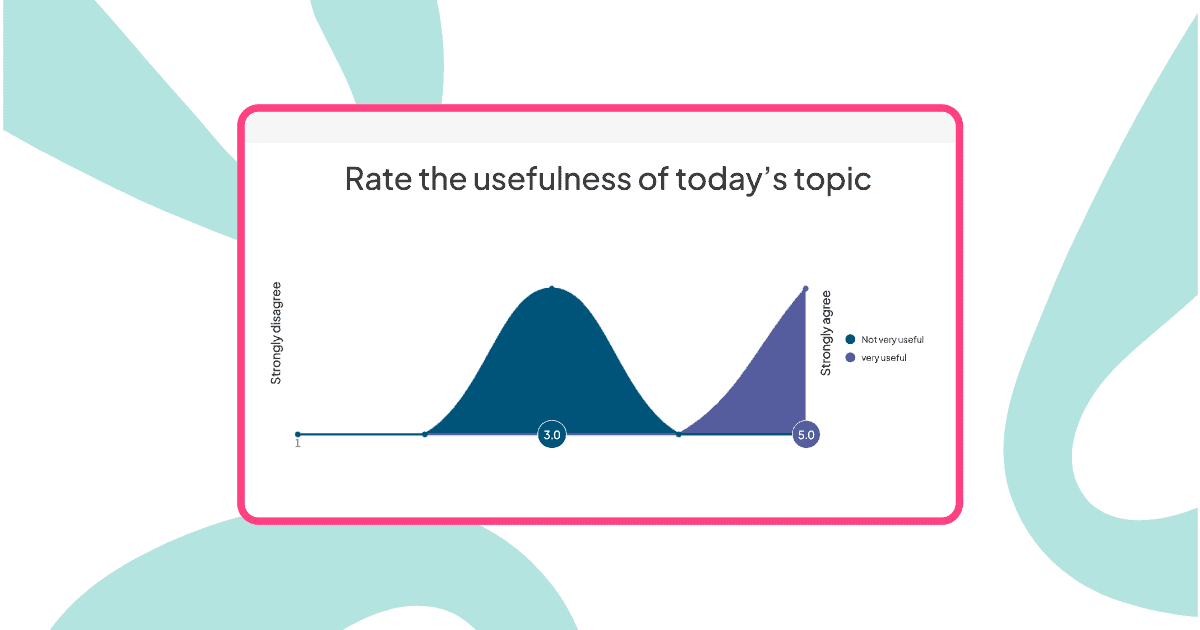An robh thu a-riamh a’ faighneachd dè cho fìor ’s a tha do luchd-obrach a’ faireachdainn mun dreuchdan, na tabhartasan aca agus an sàsachd obrach san fharsaingeachd?
Chan eil dreuchd làn-thoilichte air a cuingealachadh tuilleadh ri pàigheadh aig deireadh na mìos. Ann an linn obair iomallach, uairean sùbailte, agus dreuchdan obrach a tha ag atharrachadh, tha mìneachadh sàsachd obrach air atharrachadh gu mòr.
Seo an duilgheadas: bidh ìrean freagairt ìosal, lèirsinn dàil, agus freagairtean glan mar thoradh air sgrùdaidhean bliadhnail traidiseanta. Bidh luchd-obrach gan lìonadh leotha fhèin aig na deasgaichean aca, gun cheangal ris a’ mhionaid agus fo eagal gun tèid an aithneachadh. Mun àm a nì thu mion-sgrùdadh air na toraidhean, bidh na cùisean air a dhol am meud no air an dìochuimhneachadh.
Tha dòigh nas fheàrr ann. Bidh sgrùdaidhean eadar-ghnìomhach air sàsachd obrach a thèid a dhèanamh aig coinneamhan sgioba, tallachan baile, no seiseanan trèanaidh a’ glacadh fios-air-ais dearbhte aig an àm – nuair a tha an conaltradh as àirde agus as urrainn dhut dèiligeadh ri draghan ann an àm fìor.
Anns an stiùireadh seo, bheir sinn seachad 46 eisimpleir de cheistean airson do cheistneir sàsachd obrach, a’ sealltainn dhut mar a nì thu còmhraidhean inntinneach mu sgrùdaidhean statach, agus a’ cuideachadh le bhith a’ brosnachadh cultar àite-obrach a bhios a’ neartachadh com-pàirteachadh luchd-obrach, a’ brosnachadh ùr-ghnàthachadh, agus a’ suidheachadh an stèidh airson soirbheachas maireannach.
Clàr-innse
- Dè a th’ ann an Ceisteachan Sàsachd Obrach?
- Carson a bu chòir Ceisteachan Sàsachd Obrach a dhèanamh?
- An diofar eadar sgrùdaidhean traidiseanta agus eadar-ghnìomhach
- 46 Ceistean Sampaill airson Ceisteachan Sàsachd Obrach
- Mar a nì thu sgrùdadh sàsachd obrach èifeachdach le AhaSlides
- Carson a bhios Suirbhidhean Eadar-ghnìomhach ag Obrachadh nas Fheàrr na Foirmean Traidiseanta
- Na prìomh ghiùlan-bidhe
Dè a th’ ann an Ceisteachan Sàsachd Obrach?
'S e ceisteachan sàsachd obrach, ris an canar cuideachd sgrùdadh sàsachd luchd-obrach, inneal ro-innleachdail a bhios proifeiseantaich HR agus stiùirichean buidhne a' cleachdadh gus tuigsinn dè cho sàsaichte 's a tha an luchd-obrach nan dreuchdan.
Tha e air a dhèanamh suas de cheistean air an dealbhadh gu faiceallach gus dèiligeadh ri raointean cudromach a’ gabhail a-steach àrainneachd obrach, dleastanasan obrach, dàimhean le co-obraichean agus luchd-stiùiridh, tuarastal, cothroman fàis, sunnd, agus barrachd.
An dòigh-obrach thraidiseanta: Cuir a-mach ceangal ris an t-suirbhidh, feith gus am bi freagairtean a’ sruthadh a-steach, dèan mion-sgrùdadh air an dàta seachdainean às dèidh sin, agus an uairsin cuir atharrachaidhean an gnìomh a tha a’ faireachdainn nach eil ceangailte ris na draghan tùsail.
An dòigh-obrach eadar-ghnìomhach: Cuir ceistean beò aig coinneamhan, cruinnich fios-air-ais sa bhad tro bhòtaichean gun urra agus sgòthan fhaclan, bruidhinn air toraidhean ann an àm fìor, agus leasaich fuasglaidhean còmhla fhad ‘s a tha a’ chòmhradh ùr.
Carson a bu chòir Ceisteachan Sàsachd Obrach a dhèanamh?
Rannsachadh Pew a’ cur cuideam air gu bheil faisg air 39% de luchd-obrach nach eil fèin-fhastaichte den bheachd gu bheil an cuid obrach deatamach don dearbh-aithne iomlan aca. Tha am beachd seo air a chumadh le factaran leithid teachd-a-steach teaghlaich agus foghlam, le 47% de luchd-cosnaidh le teachd-a-steach nas àirde agus 53% de dh’ oileanaich iar-cheumnach a’ cur cudromachd air an dearbh-aithne obrach. Tha an eadar-obrachadh seo deatamach airson sàsachd luchd-obrach, agus mar sin tha ceisteachan sàsachd obrach le deagh structar riatanach airson adhbhar agus sunnd a bhrosnachadh.
Tha buannachdan mòra ann an ceisteachan sàsachd obrach a dhèanamh do luchd-obrach agus don bhuidhinn le chèile:
Tuigse Lèirsinneach
Bidh ceistean sònraichte a’ nochdadh fìor fhaireachdainnean luchd-obrach, a’ nochdadh bheachdan, draghan agus raointean riarachaidh. Nuair a thèid an dèanamh gu h-eadar-ghnìomhach le roghainnean freagairt gun urra, bidh thu a’ seachnadh an eagal dearbh-aithne a bhios gu tric a’ leantainn gu fios-air-ais mì-onarach ann an sgrùdaidhean traidiseanta.
Aithneachadh Cùise
Bidh ceistean cuimsichte a’ comharrachadh puingean pian a bheir buaidh air misneachd agus com-pàirteachadh—ge bith an e conaltradh, obair-obrach no cothroman fàis a th’ annta. Faodaidh sgòthan fhaclan fìor-ùine sealltainn sa bhad far a bheil a’ mhòr-chuid de luchd-obrach a’ strì.
Fuasglaidhean Tàillear
Leigidh na beachdan a chruinnichear le fuasglaidhean gnàthaichte, a’ sealltainn do dhealas a thaobh leasachadh suidheachaidhean obrach. Nuair a chì luchd-obrach am fios-air-ais air a thaisbeanadh sa bhad agus air a dheasbad gu fosgailte, bidh iad a’ faireachdainn gu bheil iad air an cluinntinn gu fìrinneach seach dìreach air an sgrùdadh.
Ceangal is Glèidheadh nas Fheàrr
Bidh dèiligeadh ri draghan stèidhichte air toraidhean ceisteachain ag àrdachadh conaltraidh, a’ cur ri lùghdachadh ann an tionndadh luchd-obrach agus barrachd dìlseachd. Bidh sgrùdaidhean eadar-ghnìomhach ag atharrachadh cruinneachadh fios-air-ais bho bhith na eacarsaich biùrocratach gu bhith na chòmhradh brìoghmhor.
An diofar eadar sgrùdaidhean traidiseanta agus eadar-ghnìomhach
| Cuspair | Suirbhidh thraidiseanta | Suirbhidh eadar-ghnìomhach (AhaSlides) |
|---|---|---|
| Ùine | Air a chur tro phost-d, air a chrìochnachadh leis fhèin | Air a chumail beò aig coinneamhan |
| Dh'ith am freagairt | Cuibheasachd 30-40% | 85-95% nuair a thèid a thaisbeanadh beò |
| Gun urra | Ceasnach - tha dragh air luchd-obrach mu bhith a’ tracadh | Fìor dhìomhaireachd gun fheum air logadh a-steach |
| Ceangail | A’ faireachdainn mar obair-dachaigh | A’ faireachdainn mar chòmhradh |
| toraidhean | Làithean no seachdainean às dèidh sin | Lèirsinn sa bhad, ann an àm fìor |
| Gnìomh | Air a mhoilleachadh, air a dhì-cheangal | Deasbad agus fuasglaidhean sa bhad |
| Inneal a 'Chlàir | Foirmean statach | Poileagan fiùghantach, neòil fhaclan, C&A, rangachadh |
Am prìomh lèirsinn: Bidh daoine nas an sàs nuair a bhios fios-air-ais a’ faireachdainn mar chòmhradh seach mar sgrìobhainnean.
46 Ceistean Sampaill airson Ceisteachan Sàsachd Obrach
Seo eisimpleirean de cheistean air an cur air dòigh a rèir roinn-seòrsa. Tha stiùireadh anns gach earrann air mar a chuireas tu iad air dòigh gu h-eadar-ghnìomhach airson an ionracas agus an ceangal as motha.
Àrainneachd Obrach
Ceistean:
- Ciamar a mheasas tu comhfhurtachd corporra agus sàbhailteachd an àite-obrach agad?
- A bheil thu riaraichte le glanachd agus eagrachadh na h-àite-obrach?
- A bheil thu a’ faireachdainn gu bheil faireachdainn na h-oifis a’ brosnachadh cultar obrach adhartach?
- A bheil na h-innealan agus na goireasan riatanach agad airson do chuid obrach a choileanadh gu h-èifeachdach?
Dòigh-obrach eadar-ghnìomhach le AhaSlides:
- Cleachd sgèilean rangachaidh (1-5 rionnagan) air an taisbeanadh beò
- Lean air adhart le sgòth fhaclan fosgailte: "Ann an aon fhacal, thoir cunntas air àile na h-àite-obrach againn"
- Cuir modh gun urra an gnìomh gus am bi luchd-obrach a’ measadh suidheachaidhean corporra gu h-onarach gun eagal
- Taisbean toraidhean cruinnichte sa bhad gus tòiseachadh air deasbad
Carson a tha seo ag obair: Nuair a chì luchd-obrach daoine eile a’ roinn draghan coltach ris (me, bidh grunn dhaoine a’ measadh “innealan agus goireasan” mar 2/5), bidh iad a’ faireachdainn dearbhte agus nas deònaiche mìneachadh ann an seiseanan C&F leanmhainn.
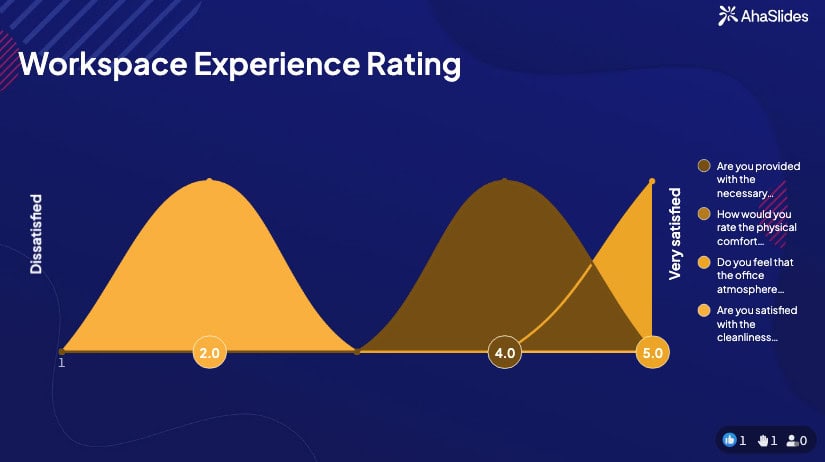
Feuch teamplaid bhòtaidh àrainneachd àite-obrach →
Iob Dleastanasan
Ceistean:
- A bheil na dleastanasan obrach agad an-dràsta a rèir do sgilean agus teisteanasan?
- A bheil na gnìomhan agad air am mìneachadh gu soilleir agus air an cur an cèill dhut?
- A bheil cothroman agad dùbhlain ùra a ghabhail os làimh agus do sgilean a leudachadh?
- A bheil thu riaraichte le measgachadh agus iom-fhillteachd do ghnìomhan làitheil?
- A bheil thu a’ faireachdainn gu bheil an obair agad a’ toirt dhut faireachdainn de dh’ adhbhar agus de choileanadh?
- A bheil thu riaraichte leis an ìre de dh’ ùghdarras co-dhùnaidh a th’ agad nad dhreuchd?
- A bheil thu a’ creidsinn gu bheil dleastanasan na h-obrach agad a’ freagairt ri amasan is misean iomlan na buidhne?
- A bheil stiùireadh soilleir agus dùilean air a thoirt dhut airson na gnìomhan agus na pròiseactan obrach agad?
- Dè cho math ’s a tha thu a’ faireachdainn gu bheil na dleastanasan obrach agad a’ cur ri soirbheachas agus fàs a’ chompanaidh?
Dòigh-obrach eadar-ghnìomhach le AhaSlides:
- Cuir cunntasan-bheachd tha/chan eil an sàs airson ceistean soilleireachd (m.e., "A bheil na gnìomhan agad air am mìneachadh gu soilleir?")
- Cleachd sgèilean rangachaidh airson ìrean riarachaidh
- Lean air adhart le C&A fosgailte: "Dè na dleastanasan a bu toil leat a chur ris no a thoirt air falbh?"
- Cruthaich neul fhaclan: "Thoir cunntas air do dhreuchd ann an trì faclan"
Pro tip: Tha am feart C&A gun urra gu sònraichte cumhachdach an seo. Faodaidh luchd-obrach ceistean mar “Carson nach eil barrachd neo-eisimeileachd againn ann a bhith a’ dèanamh cho-dhùnaidhean?” a chuir a-steach gun eagal gun tèid an aithneachadh, a’ leigeil le manaidsearan dèiligeadh ri cùisean siostamach gu fosgailte.
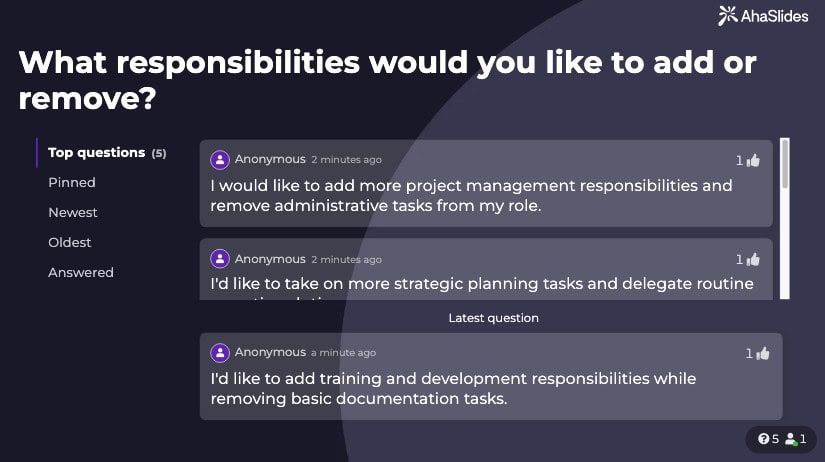
Stiùireadh agus stiùireadh
Ceistean:
- Ciamar a mheasas tu càileachd a’ chonaltraidh eadar thu fhèin agus an neach-stiùiridh agad?
- Am faigh thu fios air ais cuideachail agus stiùireadh mu do choileanadh?
- A bheil thu air do bhrosnachadh gus do bheachdan agus molaidhean a chuir an cèill don neach-stiùiridh agad?
- A bheil thu a’ faireachdainn gu bheil do mhanaidsear a’ cur luach air na chuir thu ris agus ag aithneachadh do oidhirpean?
- A bheil thu riaraichte leis an stoidhle stiùiridh agus an dòigh riaghlaidh taobh a-staigh na roinne agad?
- Dè na seòrsaichean sgilean ceannais a tha thu a’ smaoineachadh a bhiodh as èifeachdaiche san sgioba agad?
Dòigh-obrach eadar-ghnìomhach le AhaSlides:
- Cleachd sgèilean rangachadh gun urra airson fios-air-ais mothachail bho luchd-stiùiridh
- Thoir sùil air roghainnean stoidhle ceannardais (deamocratach, coidsidh, cruth-atharrachail, msaa.) agus faighnich dè an fheadhainn as fheàrr leis an luchd-obrach
- Cuir C&A beò an gnìomh far am faod luchd-obrach ceistean fhaighneachd mu dhòigh-obrach riaghlaidh
- Cruthaich rangachadh: "Dè as cudromaiche dhut ann an stiùiriche?" (Conaltradh, Aithneachadh, Beachdan, Neo-eisimeileachd, Taic)
Carson a tha cudromach gun urras: A rèir do dhuilleag-obrach suidheachaidh, feumaidh proifeiseantaich HR “àiteachan sàbhailte a chruthachadh airson deasbad onarach”. Leigidh cunntasan-bheachd eadar-ghnìomhach gun urra aig coinneamhan baile le luchd-obrach rangachadh onarach a dhèanamh air ceannardas gun draghan mu dhreuchd – rudeigin a tha sgrùdaidhean traidiseanta a’ strì ri choileanadh gu cinnteach.
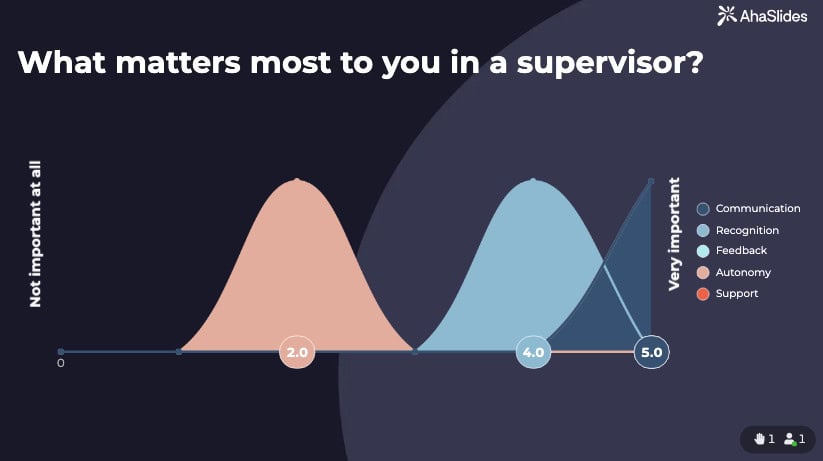
Fàs agus Leasachadh Dreuchd
Ceistean:
- A bheil cothroman ann airson fàs agus adhartas proifeiseanta a thoirt dhut?
- Dè cho riaraichte ’s a tha thu leis na prògraman trèanaidh is leasachaidh a tha a’ bhuidheann a’ tabhann?
- A bheil thu a’ creidsinn gu bheil an dreuchd a th’ agad an-dràsta a’ co-thaobhadh ris na h-amasan dreuchd fad-ùine agad?
- A bheil cothrom agad dreuchdan stiùiridh no pròiseactan sònraichte a ghabhail os làimh?
- A bheil thu a’ faighinn taic airson a bhith a’ leantainn foghlam adhartach no àrdachadh sgilean?
Dòigh-obrach eadar-ghnìomhach le AhaSlides:
- Poileadh: "Dè an seòrsa leasachaidh proifeasanta a bhiodh na bhuannachd dhut as motha?" (Trèanadh ceannardais, sgilean teicnigeach, teisteanasan, coidseadh, gluasadan taobhach)
- Nèul fhaclan: "Càit a bheil thu gad fhaicinn fhèin ann an 3 bliadhna?"
- Sgèile rangachaidh: "Dè an taic a tha thu a’ faireachdainn nad leasachadh dreuchdail?" (1-10)
- Ceistean is Freagairtean Fosgailte do luchd-obrach gus faighneachd mu chothroman leasachaidh sònraichte
Buannachd ro-innleachdail: Eu-coltach ri sgrùdaidhean traidiseanta far a bheil an dàta seo ann an duilleag-clèithe, le bhith a’ taisbeanadh cheistean leasachaidh dreuchdail beò rè lèirmheasan ràitheil, faodaidh HR beachdachadh sa bhad air buidseatan trèanaidh, prògraman coidseadh, agus cothroman gluasaid a-staigh fhad ‘s a tha a’ chòmhradh gnìomhach.
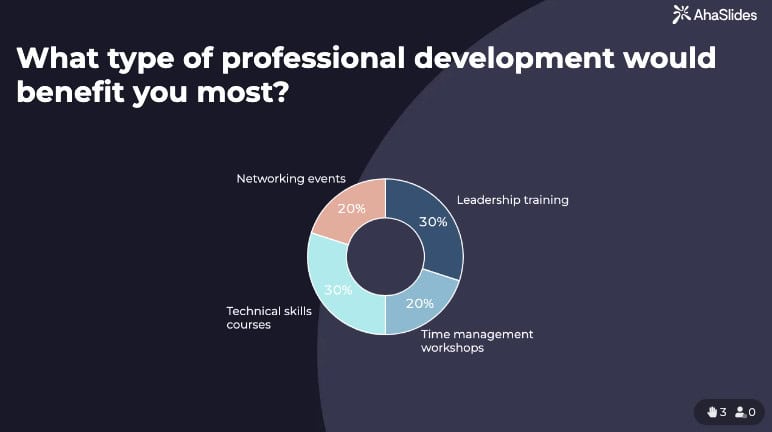
Dìoladh agus Sochairean
Ceistean:
- A bheil thu riaraichte leis a’ phasgan tuarastail is dìolaidh a th’ agad an-dràsta, a’ gabhail a-steach sochairean iomaill?
- A bheil thu a’ faireachdainn gu bheil na tabhartasan agus na coileanaidhean agad a’ faighinn duais iomchaidh?
- A bheil na buannachdan a tha an eagrachadh a’ tabhann coileanta agus freagarrach airson na feumalachdan agad?
- Ciamar a mheasadh tu follaiseachd agus cothromachd a’ phròiseas measaidh coileanaidh agus dìolaidh?
- A bheil thu riaraichte leis na cothroman airson bònasan, brosnachaidhean no duaisean?
- A bheil thu riaraichte leis a’ phoileasaidh saor-làithean bliadhnail?
Dòigh-obrach eadar-ghnìomhach le AhaSlides:
- Poileagan gun urra tha/chan eil airson ceistean tuarastail mothachail
- Ioma-roghainn: “Dè na sochairean as cudromaiche dhutsa?” (Cùram-slàinte, Sùbailteachd, Buidseat ionnsachaidh, Prògraman sunnd, Cluaineas)
- Sgèile rangachadh: "Dè cho cothromach 's a tha an dìoladh againn an coimeas ris a' chuibhreann agad?"
- Nèul fhaclan: "Dè an aon bhuannachd a leasaicheadh do shàsachadh as motha?"
Nota chudromach: Seo far a bheil sgrùdaidhean eadar-ghnìomhach gun urra a’ deàrrsadh. Is ann ainneamh a bheir luchd-obrach fios-air-ais onarach mu thuarastal ann an sgrùdaidhean traidiseanta a dh’ fheumas teisteanasan logadh a-steach. Bidh cunntasan-bheachd beò gun urra aig coinneamhan baile, far am bi freagairtean a’ nochdadh gun ainmean, a’ cruthachadh sàbhailteachd saidhgeòlach airson fios-air-ais fìor.
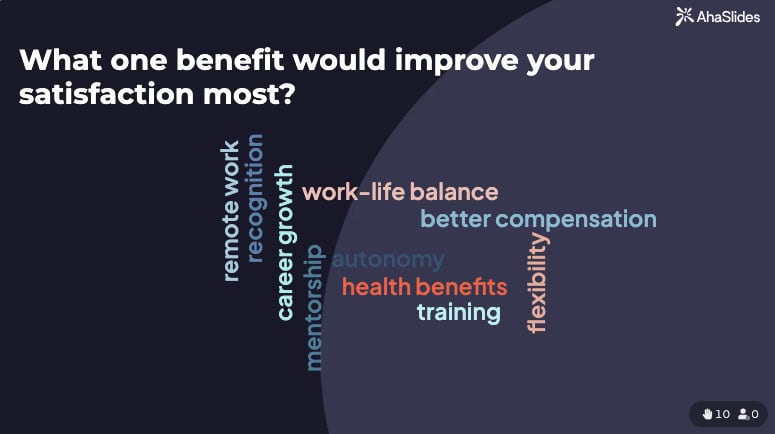
Cruthaich do sheisean fios-air-ais airson tuarastail →
Dàimhean agus Co-obrachadh
Ceistean:
- Dè cho math ’s a tha thu a’ co-obrachadh agus a’ conaltradh ri do cho-obraichean?
- A bheil thu a’ faireachdainn mothachadh air com-pàirteachas agus obair-sgioba taobh a-staigh na roinne agad?
- A bheil thu riaraichte leis an ìre spèis agus co-obrachaidh am measg do cho-aoisean?
- A bheil cothroman agad eadar-obrachadh le co-obraichean bho dhiofar roinnean no sgiobaidhean?
- A bheil thu comhfhurtail a’ sireadh cuideachadh no comhairle bho do cho-obraichean nuair a bhios feum air?
Dòigh-obrach eadar-ghnìomhach le AhaSlides:
- Sgèilean rangachaidh airson càileachd co-obrachaidh
- Nèul fhaclan: "Thoir cunntas air cultar na sgioba againn ann an aon fhacal"
- Ioma-roghainn: "Dè cho tric 's a bhios tu ag obair còmhla thar roinnean?" (Gach latha, Gach seachdain, Gach mìos, Gu math ainneamh, Gu bràth)
- C&A gun urra gus cùisean eadar-phearsanta a thoirt am follais
Sunnd agus Cothromachadh Obair-Beatha
Ceistean:
- Dè cho riaraichte ’s a tha thu leis a’ chothromachadh eadar obair is beatha a tha a’ bhuidheann a’ toirt seachad?
- A bheil thu a’ faireachdainn gu bheil taic iomchaidh agad bhon chompanaidh ann a bhith a’ stiùireadh cuideam agus a’ cumail suas do shunnd inntinn?
- A bheil thu comhfhurtail a’ sireadh taic no goireasan airson a bhith a’ riaghladh dhùbhlain pearsanta no co-cheangailte ri obair?
- Dè cho tric ’s a bhios tu an sàs ann am prògraman no gnìomhan sunnd a tha air an toirt seachad leis a’ bhuidheann?
- A bheil thu a’ creidsinn gu bheil a’ chompanaidh a’ cur luach air agus a’ toirt prìomhachas do shunnd a luchd-obrach?
- A bheil thu riaraichte leis an àrainneachd obrach corporra a thaobh comhfhurtachd, solais, agus ergonomics?
- Dè cho math ’s a tha a’ bhuidheann a’ dèiligeadh ri na feumalachdan slàinte is sunnd agad (m.e., uairean sùbailte, roghainnean obrach iomallach)?
- A bheil thu a’ faireachdainn gu bheil thu air do bhrosnachadh gus fois a ghabhail agus dì-cheangal bhon obair nuair a bhios feum air ath-lìonadh?
- Dè cho tric ’s a tha thu a’ faireachdainn cus no fo uallach air sgàth factaran co-cheangailte ri obair?
- A bheil thu riaraichte leis na buannachdan slàinte is sunnd a tha an eagrachadh a’ tabhann?
Dòigh-obrach eadar-ghnìomhach le AhaSlides:
- Sgèilean tricead: "Dè cho tric 's a bhios tu a' faireachdainn cuideam?" (Gu bràth, ainneamh, uaireannan, tric, an-còmhnaidh)
- Bhòtaichean tha/chan eil air taic sunnd
- Sleamhnag gun urra: "Rangaich an ìre losgadh-amach agad an-dràsta" (1-10)
- Nèul fhaclan: "Dè a leasaicheadh do shunnd as motha?"
- Ceistean is Freagairtean Fosgailte do luchd-obrach gus draghan mu shunnd a cho-roinn gun urra
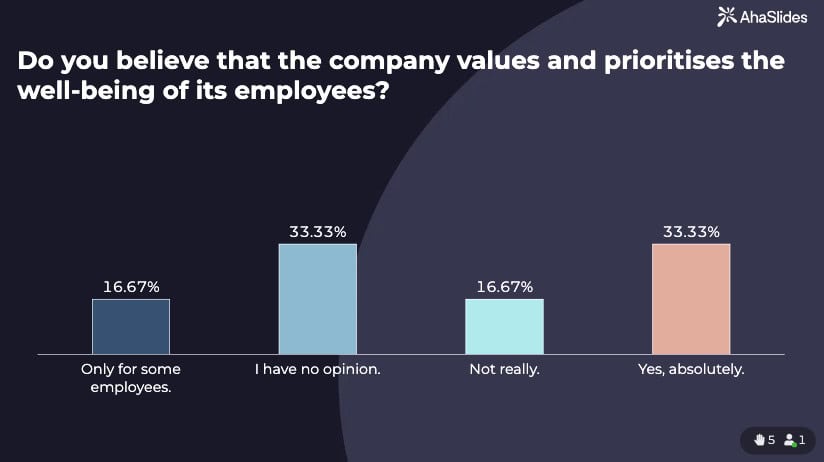
Carson a tha seo a 'tachairt: Tha an duilleag-obrach suidheachaidh agad ag aithneachadh gu bheil proifeiseantaich HR a’ strì le “com-pàirteachadh is fios-air-ais luchd-obrach” agus “àiteachan sàbhailte a chruthachadh airson deasbad onarach”. Tha ceistean sunnd mothachail gu nàdarrach—tha eagal air luchd-obrach a bhith a’ coimhead lag no neo-dhìleas ma dh’aidicheas iad gu bheil iad air an losgadh a-mach. Bidh sgrùdaidhean eadar-ghnìomhach gun urra a’ toirt air falbh a’ bhacadh seo.
Sàsachd iomlan
Ceist mu dheireadh: 46. Air sgèile bho 1-10, dè cho coltach 's a tha e gum molaidh tu a' chompanaidh seo mar àite math airson obair? (Sgòr Àrd-neach-adhartachaidh Glan Luchd-obrach)
Dòigh-obrach eadar-ghnìomhach:
- Leantainn suas stèidhichte air toraidhean: Ma tha sgòran ìosal, faighnich sa bhad "Dè an aon rud a dh'fhaodadh sinn atharrachadh gus an sgòr agad a leasachadh?"
- Taisbean an eNPS ann an àm fìor gus am faic ceannardas faireachdainn sa bhad
- Cleachd toraidhean gus còmhradh follaiseach a bhrosnachadh mu leasachaidhean buidhne
Mar a nì thu sgrùdadh sàsachd obrach èifeachdach le AhaSlides
Ceum 1: Tagh do chruth
Roghainn A: Beò aig coinneamhan uile-làimh
- Thoir seachad 8-12 ceistean cudromach aig coinneamhan baile ràitheil
- Cleachd modh gun urra airson cuspairean mothachail
- Bruidhinn air na toraidhean sa bhad leis a’ bhuidheann
- As fheàrr airson: A’ togail earbsa, gnìomh sa bhad, fuasgladh cheistean co-obrachail
Roghainn B: Fèin-astar ach eadar-ghnìomhach
- Roinn ceangal taisbeanaidh as urrainn do luchd-obrach faighinn thuige aig àm sam bith
- Cuir a-steach na 46 ceistean uile air an eagrachadh a rèir roinn-seòrsa
- Suidhich ceann-latha airson a chrìochnachadh
- As fheàrr airson: Cruinneachadh dàta coileanta, ùine sùbailte
Roghainn C: Dòigh-obrach measgaichte (air a mholadh)
- Cuir 5-7 ceistean cudromach mar bhòtaichean aig astar fhèin
- Cuir na toraidhean agus na 3 prìomh dhraghan an cèill beò aig an ath choinneamh sgioba
- Cleachd C&A beò gus sgrùdadh nas doimhne a dhèanamh air cùisean
- As fheàrr airson: Com-pàirteachadh as motha le deasbad brìoghmhor
Ceum 2: Suidhich do sgrùdadh ann an AhaSlides
Feartan ri chleachdadh:
- Ìrean rangachadh airson ìrean riarachaidh
- Taghaidhean ioma-roghainn airson ceistean roghainn
- Sgòthan facal gus cuspairean cumanta a mhìneachadh
- Fosgail C&A airson luchd-obrach ceistean gun urra fhaighneachd
- Modh gun urra gus sàbhailteachd inntinn a dhèanamh cinnteach
- Taisbeanadh thoraidhean beò gus follaiseachd a nochdadh
Molaidhean airson ùine a shàbhaladh: Cleachd gineadair AI AhaSlides gus an sgrùdadh agad a chruthachadh gu sgiobalta bhon liosta cheistean seo, agus an uairsin gnàthaich e airson feumalachdan sònraichte na buidhne agad.
Ceum 3: Cuir an t-Adhbhar an cèill
Mus tòisich thu air an sgrùdadh agad, mìnich:
- Carson a tha thu ga dhèanamh (chan ann dìreach "leis gu bheil an t-àm ann airson sgrùdaidhean bliadhnail")
- Mar a thèid freagairtean a chleachdadh
- Gu bheil freagairtean gun urra dha-rìribh gun urra
- Cuin agus ciamar a roinneas tu toraidhean agus a ghabhas tu ceumannan
Sgriobt togail earbsa: "Tha sinn airson tuigsinn dè do bheachd dha-rìribh air a bhith ag obair an seo. Tha sinn a’ cleachdadh bhòtaichean eadar-ghnìomhach gun urra oir tha fios againn nach eil sgrùdaidhean traidiseanta a’ glacadh do bheachdan onarach. Nochdaidh na freagairtean agad gun ainmean, agus bruidhnidh sinn air na toraidhean còmhla gus fuasglaidhean a leasachadh gu co-obrachail."
Ceum 4: Taisbeanadh Beò (Mas E Iomchaidh)
Structar coinneimh:
- Ro-ràdh (2 mhionaid): Mìnich an adhbhar agus an dìomhaireachd
- Ceistean an t-suirbhidh (15-20 mionaid): Taisbeanadh bhòtaichean aon às dèidh a chèile, a’ sealltainn thoraidhean beò
- Deasbad (15-20 mionaid): Dèiligeadh ri prìomh dhraghan sa bhad
- Planadh gnìomh (10 mionaidean): Gealltainn do cheumannan sònraichte a leanas
- C&F leanmhainn (10 mionaidean): Làr fosgailte airson ceistean gun urra
Pro tip: Nuair a nochdas toraidhean mothachail (me, tha 70% den bheachd gu bheil conaltradh ceannardais bochd), aithnich iad sa bhad: "Is e fios-air-ais cudromach a tha seo. Bruidhnidh sinn air dè tha 'droch chonaltradh' a' ciallachadh dhutsa. Cleachd an C&A gus eisimpleirean sònraichte a cho-roinn gun urra."
Ceum 5: Gnìomhaich air na Toraidhean
Seo far a bheil sgrùdaidhean eadar-ghnìomhach a’ cruthachadh buannachd farpaiseach. Leis gu bheil thu air fios-air-ais a chruinneachadh rè còmhraidhean beò:
- Tha luchd-obrach air toraidhean fhaicinn mu thràth
- Tha thu air gealltainn gnìomhan a dhèanamh gu poblach
- Tha dùil ri leantainn agus tha e ri fhaicinn
- Bidh earbsa a’ fàs nuair a thèid geallaidhean a chumail
Teamplaid plana gnìomha:
- Roinn toraidhean mionaideach taobh a-staigh 48 uairean
- Comharraich na 3 prìomh raointean airson leasachadh
- Cruthaich buidhnean-obrach gus fuasglaidhean a leasachadh
- Cuir fios air adhartas gach mìos
- Ath-sgrùdadh ann an 6 mìosan gus leasachadh a thomhas
Carson a bhios Suirbhidhean Eadar-ghnìomhach ag Obrachadh nas Fheàrr na Foirmean Traidiseanta
A rèir feumalachdan na buidhne agad, feumaidh tu:
- "Tomhais com-pàirteachadh luchd-obrach rè iomairtean HR"
- "Cuir seiseanan C&A gun urra air dòigh ann an tallachan a' bhaile"
- "Cruinnich beachdan luchd-obrach le bhith a’ cleachdadh sgòthan fhaclan agus cunntasan-bheachd beò"
- "Cruthaich àiteachan sàbhailte airson deasbad onarach"
Chan urrainn dha innealan traidiseanta suirbhidh mar Google Forms no SurveyMonkey an t-eòlas seo a lìbhrigeadh. Bidh iad a’ tional dàta, ach chan eil iad a’ cruthachadh còmhraidh. Bidh iad a’ tional fhreagairtean, ach chan eil iad a’ togail earbsa.
Bidh àrd-ùrlaran eadar-ghnìomhach mar AhaSlides ag atharrachadh cruinneachadh fios-air-ais bho eacarsaich biùrocratach gu còmhradh brìoghmhor. far:
- Tha luchd-obrach a’ faicinn gu bheil na guthan aca cudromach ann an àm fìor
- Tha stiùirichean a’ nochdadh dealas sa bhad do bhith ag èisteachd
- Bidh neo-ainmeachd a’ toirt air falbh eagal agus bidh follaiseachd a’ togail earbsa
- Bidh deasbad a’ leantainn gu fuasglaidhean co-obrachail
- Bidh dàta na dhòigh air còmhradh a thòiseachadh, chan e aithisg a tha na shuidhe ann an drathair
Na prìomh ghiùlan-bidhe
✅ Tha sgrùdaidhean riarachaidh obrach nan innealan ro-innleachdail, chan e bogsaichean-seic rianachd. Bidh iad a’ nochdadh dè a bhios a’ brosnachadh conaltraidh, gleidheadh agus coileanadh.
✅ Bheir sgrùdaidhean eadar-ghnìomhach toraidhean nas fheàrr na cruthan traidiseanta—ìrean freagairt nas àirde, fios-air-ais nas onarach, agus cothroman deasbaid sa bhad.
✅ Neo-aithneachadh agus follaiseachd a’ cruthachadh an sàbhailteachd inntinn a tha a dhìth airson fios-air-ais fìrinneach. Bidh luchd-obrach a’ freagairt gu h-onarach nuair a tha fios aca gu bheil freagairtean gun urra ach chì iad gu bheil stiùirichean a’ gabhail gnìomh.
✅ Tha na 46 ceistean san stiùireadh seo a’ còmhdach tomhasan cudromach sàsachd obrach: àrainneachd, dleastanasan, ceannardas, fàs, tuarastal, dàimhean, agus sunnd.
✅ Leigidh toraidhean fìor-ùine le gnìomh sa bhad. Nuair a chì luchd-obrach am fios-air-ais air a dhealbhadh sa bhad agus air a dheasbad gu fosgailte, bidh iad a’ faireachdainn gu bheil iad air an cluinntinn seach dìreach air an sgrùdadh.
✅ Tha innealan cudromach. Bidh àrd-ùrlaran mar AhaSlides le cunntasan-bheachd beò, neòil fhaclan, ceistean is freagairtean gun urra, agus taisbeanaidhean thoraidhean fìor-ùine a’ tionndadh ceisteachain statach gu còmhraidhean fiùghantach a bhios a’ brosnachadh atharrachadh buidhne.
Tùsan:




